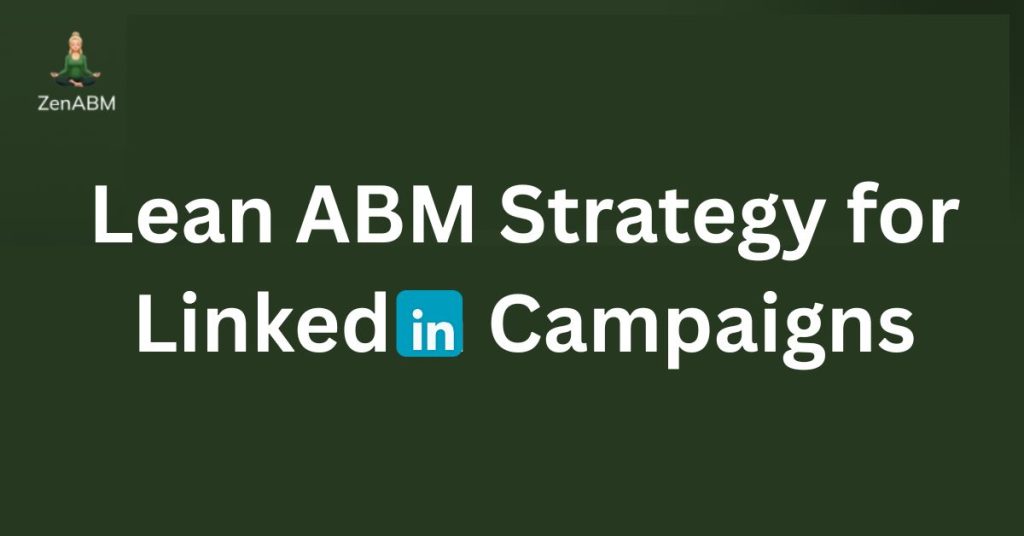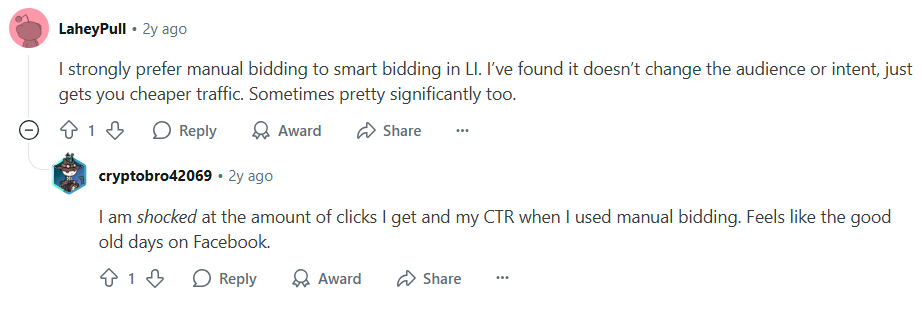When I first read about ABM and saw how most ABM tools (ZenABM excluded) cost no less than $10K+ per year, I wondered what’s the entry point.
Like, I don’t have the guts to run to my superiors and say, “Fund me $30K for an ABM campaign to pay for tools and talent, and no, I haven’t done it before. It’s my first time.”
So, if you even have such restraints as:
- Never did ABM before
- The projected ACV doesn’t match the budget required
- The C-suite executives are hesitant
Or anything similar that’s stopping you. I have laid down this lean ABM strategy for LinkedIn campaigns.
And why on LinkedIn? I have answered that too.
Read on…
Lean ABM Strategy for LinkedIn Campaigns: Quick Summary
- Start with a tiny, ICP-perfect TAL from CRM wins, enrich with Sales Navigator, BuiltWith, Crunchbase, and Clay.
- Upload a company list to LinkedIn and layer job function, title, and seniority. Avoid contact uploads unless needed.
- Split campaigns by company size and persona. Under 500 include managers. 500 plus focus on director and above.
- Launch 5 to 8 pain-led creatives per persona. One idea per ad. Rotate weekly.
- Cap frequency near 3 per week. Exclude customers, interns, HR, and competitors.
- Define MQA thresholds at the account level, for example, 5 clicks or 2 high-intent page views.
- Hand off MQAs to BDRs within 24 to 48 hours with context on which ad themes they engaged.
- Retarget only TAL engagers with case studies, comparisons, and demo CTAs.
- Track account progression and pipeline per dollar, not vanity clicks. Replace dark accounts every 4 to 6 weeks.
- Use ZenABM to pull company-level impressions, clicks, and intent, push to CRM, and automate BDR assignment.
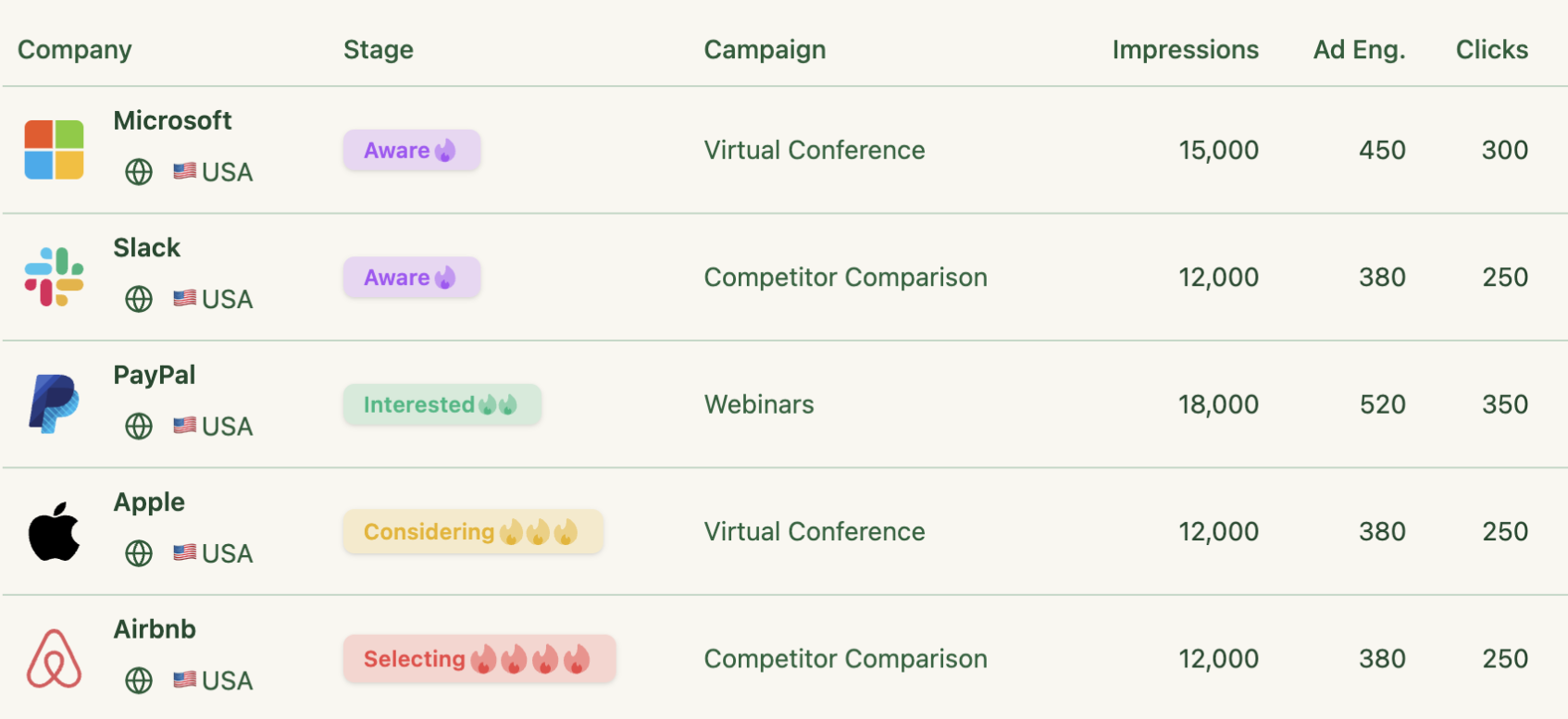
What Is “Lean ABM” and Why Use LinkedIn?
Account-Based Marketing traditionally involves big budgets and extensive resources to target key accounts with personalized campaigns.
“Lean ABM” reimagines this playbook for smaller teams and budgets, achieving strategic impact without the hefty price tag.
In lean ABM, every effort is highly targeted and purposeful, ensuring you invest only where it counts.
And LinkedIn excels as an ABM channel for lean ABM (in general, too) due to its rich professional data and targeting options.
You can segment audiences by company, industry, job title, seniority, and more, meaning your ads reach precisely the right people at your target accounts.
I mean, look at the filters available in LinkedIn Sales Navigator:
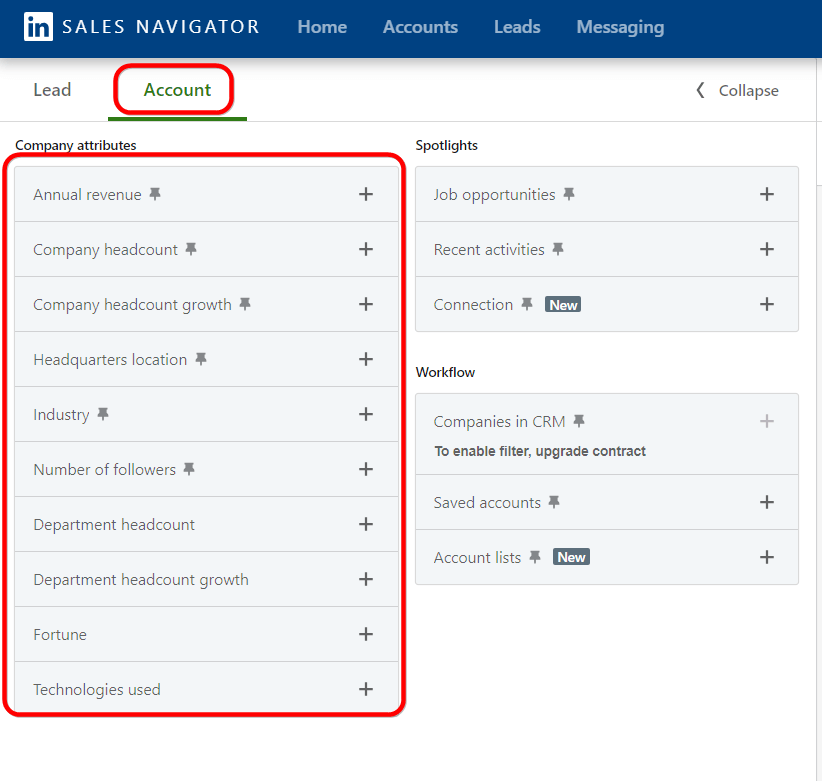
You can make your TAL with it, and then LinkedIn Campaign Manager will let you target that exact list of accounts, look-alikes, etc.
This makes it possible to run one-to-many ABM plays at scale on LinkedIn: you upload a list of target companies or contacts that match your ICP and serve ads only to those accounts.
Note: LinkedIn ads are expensive on a CPC/CPM basis, but their impact makes them worthwhile if you stay lean. The key is to tightly define your target list, use smart segmentation, and coordinate ads with sales touches – all to avoid wasting spend on people or companies that won’t move the needle.
Questions to Answer Before You Start Lean ABM
Before diving in, ensure you’ve answered some fundamental planning questions for your ABM program.
- Goals & KPIs: Define what you want from your LinkedIn ABM campaigns (pipeline generated, deal velocity, etc.) and leading indicators to watch (CTR, engagement rate).
- Level of Personalization: Decide if you’re doing one-to-many, one-to-few, or one-to-one campaigns. A lean approach often starts one-to-many (targeting a broader set of similar accounts) to gather data, then narrows to one-to-few for high-value segments.
- Timeline: Determine campaign duration and stages. Many teams run ABM campaigns in stages aligned to the buyer’s journey (awareness, consideration, decision) with criteria for moving accounts between stages.
- Channels: We focus on LinkedIn here, but consider how other channels (email, sales outreach, events, etc.) will coordinate. Lean ABM leverages multi-channel touchpoints without a lot of spend – e.g. LinkedIn ads for air cover, plus free touchpoints like personalized emails or LinkedIn direct messages.
- Budget: Set a realistic budget and account volume based on your goals. Reverse-engineer how many accounts and opportunities you need to hit revenue targets, then ensure you can afford the necessary ad spend for that scale. (LinkedIn’s minimum audience size is 300 people. If your target list yields fewer, you’ll need to broaden it or add contacts.
- Metrics & Tools: Plan how you’ll track account-level engagement and success. LinkedIn’s Campaign Manager has a “Companies” report for account-level metrics, but you may need a CRM or ABM tool to connect ad engagement to pipeline and also show you company-level ad engagement for each creative. ZenABM can help with that. It tracks company-level impressions, engagements and clicks from LinkedIn’s official ads API for each ad creative and campaign group:
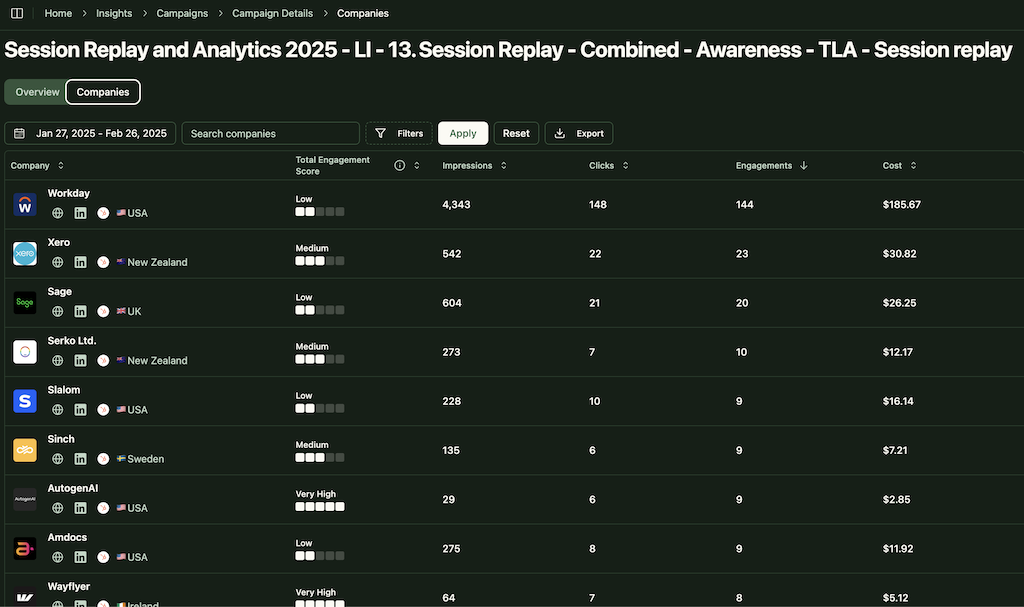
- And then matches engaged companies with the ones in your CRM deals to map LinkedIn ad influence to pipeline and revenue:

With groundwork laid, let’s get hands-on with building a lean ABM strategy for a LinkedIn campaign step by step.
1. Build a Laser-Focused Target Account List (TAL)
A solid Target Account List (TAL) is the backbone of ABM, and especially vital when you have a limited budget.
In lean ABM, every account on your list must truly fit your ideal customer profile (ICP) and have high potential value.
If your account list is wrong or too broad, everything else will flounder.
Here’s how to get it right:
Define Your ICP Criteria
Work closely with sales and leadership to nail down the firmographics and other traits that define a high-value account for you.
Think company size, industry, region, tech stack, revenue, growth stage, etc.
Don’t just dream of landing Fortune 500 logos; base your criteria on where you’ve actually seen success.
For example, the Userpilot marketing team analyzed their past win-loss deals to find commonalities among the customers that closed and those that didn’t.
They identified segments where their product fit best (e.g. SaaS companies of 50–2,000 employees in certain regions), then built the enriched account list using Clay with Builtwith’s API and focused on it:
Utilize Internal Data First
The lean way to build a TAL is to mine your own data.
Look at your CRM for:
- past closed-won deals (who became a customer and why?),
- late-stage opportunities or closed-loss (which accounts showed promise even if they didn’t close),
- and any high-profile targets your sales team is already pursuing.
Also, loop in your sales team early. ABM lists built in a silo often miss the mark.
Sales reps can name their “dream accounts,” but also validate whether those big logos are realistic or if mid-tier accounts might convert better. For instance, don’t just grab the top 50 biggest companies in your space; cross-check which types of companies progressed furthest in your funnel historically.
Quality Over Quantity
In lean ABM, less is more.
You might start with just 50–100 high-priority accounts for your first LinkedIn campaign.
It’s better to deeply engage 50 right-fit accounts than to marginally touch 500 random ones.
So, while deciding on your TAL, have more disqualification criteria than qualification criteria.
Use Targeting Tools (Smartly)
For finding net-new accounts that fit your criteria, LinkedIn Sales Navigator is a powerful ally.
- You can search for companies by filters like industry, employee count, geography, technologies used, and more:

- For example, filter for companies in your ICP industries with 50-500 employees in the US, and you’ll get a list of prospects to vet.
- Export or save those leads, then refine. Other tools can enrich or augment your list: e.g. BuiltWith for technographics (to find companies using or avoiding certain software), Crunchbase for funding and growth signals, or even Google for searching for keywords like “top [your vertical] companies”.
- You can use Clay to get access to different types of data providers in one place.
Free Resource: We interviewed many GTM/Clay experts to know how they were using Clay for ABM. Learn the 7 pro methods here.
Refine and Vet Manually
Don’t rely blindly on automated list builds.
Go through the list and spot-check each account.
Remove subsidiaries or very low-revenue companies if those aren’t viable customers.
Ensure no obvious mismatches (e.g., if you only sell to SaaS companies, drop any manufacturing firms that slipped in).
This upfront hygiene saves budget later.
Also, data hygiene is critical: One pro tip is to standardize company naming in your CRM and deduplicate records before launching ABM, so all contacts from one account roll up correctly. Clean data in = clean targeting out!
Now that you know which accounts to target, the next step is identifying whom to target within them.
2. Identify Key Personas and Gather Contacts
A lean ABM strategy focuses on the key personas who matter and uses tools to reach them efficiently.
Map the Buying Committee
For each target account, map out the roles you need to engage.
Common personas include the economic buyer (e.g. CXO or VP), the champion/user (maybe a director or manager who would use your product), and other influencers (IT, security, etc., depending on what you sell).
If you’ve developed buyer personas, align them to your target accounts now.
For example, a SaaS ABM campaign might target the Head of Product (economic buyer), a Product Manager (user champion), and maybe a UX Lead or Engineer (influencer) at each account.
Build mini “account profiles” noting these people’s pain points and current solutions – this will inform your ad messaging and sales outreach later.
Find Contacts via LinkedIn
The lean approach to gather contacts is using LinkedIn itself.
With your Sales Navigator or even basic LinkedIn, search each target company’s employees for titles that match your personas (e.g. filter by “current company = X” and title contains “Product” or “UX”).
This manual step can be time-consuming for hundreds of accounts, so prioritize top-tier accounts for bespoke research.
For a broader approach, LinkedIn allows Matched Audiences by company without needing individual emails: you can simply upload a list of company names to LinkedIn Campaign Manager and then layer targeting for specific job titles, functions, or seniorities.
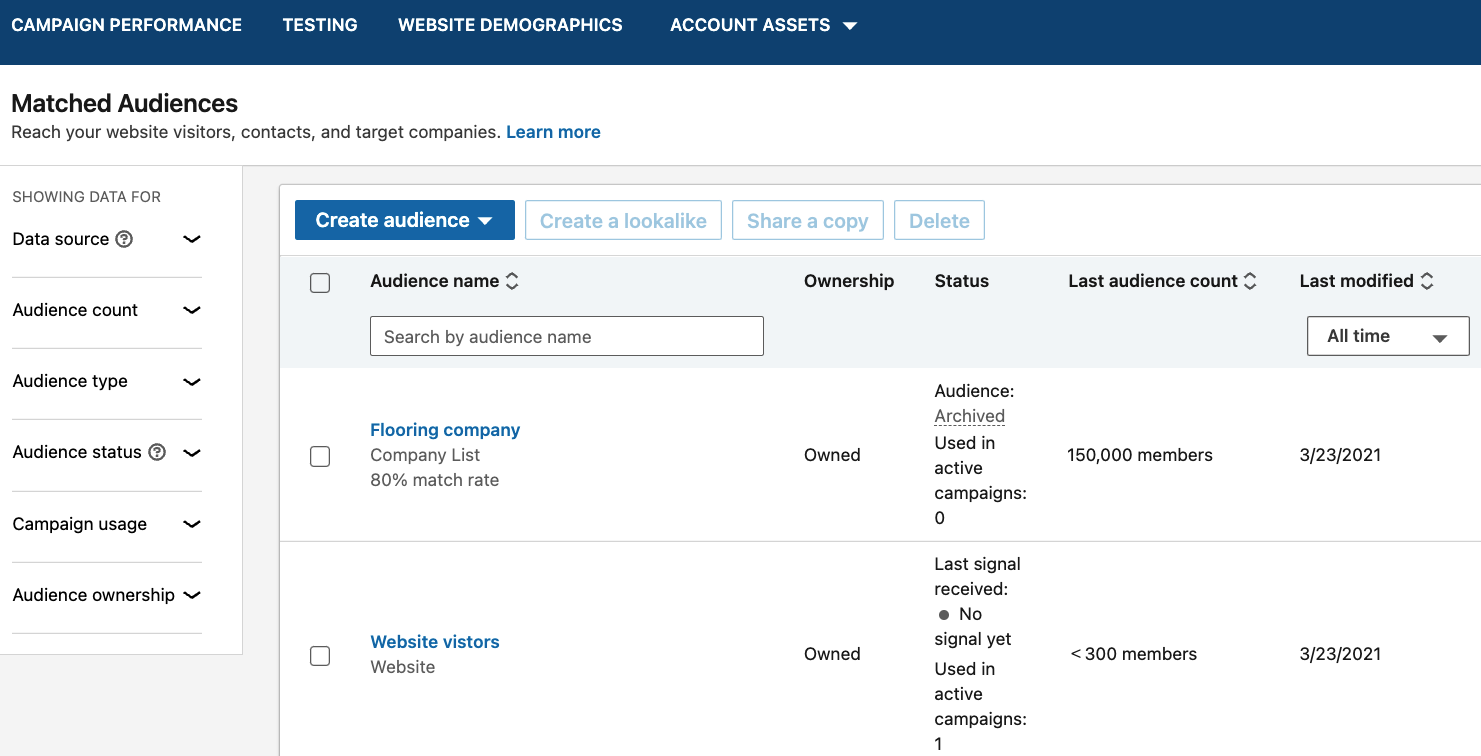
This method is highly recommended for scale.
Why?
Because uploading a company list yields a 95–100% match rate on LinkedIn (LinkedIn knows nearly all company names), and then LinkedIn will automatically include all relevant people at those companies who meet your role criteria.
In contrast, uploading individual contact emails often results in only 30–70% match and can go stale as people change jobs.
A lean strategy avoids that maintenance headache.
Bottom line: Upload your target companies as a list to LinkedIn, then use filters (like “Job Function = Marketing” + “Seniority = Director+”) to zero in on the personas at those firms. LinkedIn will handle including new employees or excluding departed ones automatically, which is gold for keeping your audience fresh.
Enrich with Other Tools (if needed)
If you do need specific contact info (say, for email outreach or to meet the 300-member minimum on LinkedIn), tools like Apollo.io or ZoomInfo can help.
Apollo, for instance, has a free plan that lets you pull a limited number of contacts by filtering by company and title.
The Userpilot team utilized Apollo and Clay to find persona contacts for each account and even enriched them with attributes like “Persona” and “Seniority” in their CRM.
They created separate lists in HubSpot CRM for each persona and stage – for example, “Target Account – Product Managers – Identified stage” and synced those as audiences to LinkedIn Campaign Manager using HubSpot Ad Audiences.
This ensured their ads could be tailored by persona segment.
Aim for Multiple Contacts per Account
To maximize impact at an account, try to include 2-5 contacts for SMBs and 5-10+ for bigger enterprises in your LinkedIn targeting.
Remember: LinkedIn requires at least 300 individuals in an audience to run ads. If your account list is very small, you might not hit that number. That’s another reason to ensure you have a few personas at each account. For example, 50 accounts × 4 personas each = 200 contacts, still below the threshold; you’d want ~75 accounts or expand personas. You can also combine multiple account lists into one campaign to meet the size requirement if you plan to show them the same ads. Just be mindful not to lump totally dissimilar accounts together; maintain some coherence for your messaging.
Validate Contact Data
As a final step, sanity-check that the people you’re targeting are current and relevant.
LinkedIn’s Demographics breakdown in Campaign Manager can show you which job titles, industries, etc., your ads are actually hitting.
Use this to spot anomalies once your campaign runs: if you see a chunk of “Interns” or unrelated job functions, you may need to adjust filters or exclusions (more on exclusions later).
By now, you should have a crisp list of target accounts and the personas to target on LinkedIn at those accounts.
You’ve effectively defined who you’ll reach. Next, we tackle how to reach them with LinkedIn ads in the most efficient, impactful way possible.
3. Crafting High-Impact LinkedIn Campaigns (Lean and Mean)
A lean ABM campaign on LinkedIn usually involves multi-stage advertising: you’ll run highly targeted ads to your list, monitor engagement, and then follow up with more personalized touches.
Here’s how to execute it:
A. Campaign Structure & Segmentation
- Start One-to-Many, Then Narrow: If this is your first ABM campaign, consider a one-to-many approach initially – one set of ads to a broad segment of your target accounts – to gauge interest. For instance, you might target all accounts on your list with an “awareness” campaign featuring thought leadership content. The goal is to see which accounts bite. Once you identify engaged accounts (say those with multiple ad clicks or video views), you can move them to a more focused one-to-few campaign with deeper product messaging, or flag them for sales follow-up. This layered approach is exactly how Userpilot ran their LinkedIn ABM: an initial awareness stage for many accounts, then different ad sets and outreach once an account showed intent.
- Segment by Account Characteristics: To keep things lean, you don’t want 50 separate campaigns, but a little segmentation goes a long way. A pro tip is to separate campaigns by company size tier. Why? A CEO at a 50-person startup will respond differently than a VP at a 10,000-person enterprise. Also, LinkedIn’s ad delivery algorithm can over-allocate budget to larger companies (with more employees to serve ads to) if they’re mixed with small ones. By splitting, you ensure small accounts get visibility too, and you can tailor messaging: e.g. in a “SMB accounts” campaign, you might speak directly to the CEO’s concerns, while in an “Enterprise accounts” campaign, you focus on specific department pain points and might target just VPs/directors (excluding lower managers). One practitioner recommends two buckets: Under 500 employees and 500+ employees. In the >500 bucket, they exclude mid-level managers since those companies have plenty of higher-ups, and you want to focus the budget on senior decision-makers. In the <500 bucket, including managers is fine because at smaller firms, managers often have direct influence and access to leadership. This split also let them adjust ad copy tone: executives at small firms got high-level, direct messaging, whereas senior managers at big firms got more tactical pain-point messaging.
- Consider Persona or Industry Splits: If your accounts span very different industries or if you have distinct personas, you may segment by those as well. For example, you might run separate campaigns for “Finance Industry Accounts” vs. “Healthcare Accounts” if their needs differ greatly. Or separate ads for technical personas vs. business personas. The Userpilot team created 8 persona-specific ad streams in their first ABM campaign (e.g. one set of ads for Product Managers, another for Heads of Product, etc.), with ~100 ad variants in total across those personas. This is more granular, but it paid off by letting each persona see messages tailored to their unique pain points. Start as segmented as you can manage. Just remember each segment needs its own creatives and budget, so don’t overdo it if you’re a one-person marketing team.
B. Ad Content & Creative Strategy
- Message Matters: In ABM, relevance is king. Your ads should speak directly to the pains and needs of your target personas at those target accounts. Avoid generic slogans or stock phrases. A practical tip is to use the research from your account profiles and sales team: call out common pain points or goals. For instance, if you know many of your targets use Competitor X, an awareness ad could be “Struggling with [Competitor X]’s limitations? Here’s how [Your Solution] helps product teams…” – something that instantly grabs the attention of someone at those accounts.
- Ad Formats: Use a mix of LinkedIn ad formats to keep things fresh and appeal to people’s preferences. Common formats for ABM: Sponsored Content single-image ads (versatile for most messages), Video ads (great for storytelling or demos), Document ads (offer a sneak peek of a whitepaper or case study that can be super relevant), and Text Ads or Dynamic Ads (these appear in the sidebar; they have lower click-through but can be very cheap impressions to keep your brand present). Message Ads/InMail can be used sparingly to deliver a more personal invite (e.g. invite to a webinar or offer a free audit), but be careful, many users find unsolicited InMails spammy. Stick to high-value content if you use them Think of what “gateway asset” you can offer that would interest your targets (a benchmark report, toolkit, etc.). Use that in your first ads to get engagement, rather than pitching your product outright.
- Personalization (1:1 Ads): For high-value accounts, you can attempt one-to-one personalized ads – e.g. referencing the company name or a specific insight about them. For example, an image ad that says “How [Target Company] Can Improve Customer Retention in 2024” will naturally catch the eye of folks at that company. However, be mindful of scale and privacy. You’d need separate creatives for each account, which is only feasible for a small handful of top accounts. Also, avoid doing this for EU companies like those in Germany because hyper-personalized ads can come off as creepy or even run afoul of privacy expectations in certain regions. If you do 1:1 ads, keep it professional and value-focused (highlight something about their industry or market, not personal info).
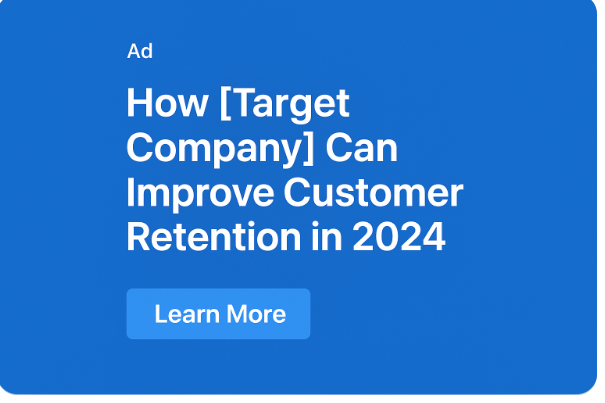
- Keep Copy Short & Punchy: On LinkedIn, users scroll quickly. Write ad headlines and text that get to the point in 1–2 sentences. Mention the pain point or outcome right up front (“Cut onboarding time by 50%” or “Frustrated with manual data prep?”). Use language that your audience uses. If targeting technical folks, a bit of jargon or specificity shows you understand their world. If targeting C-suite, keep it high-level and outcomes-focused (ROI, revenue, risk). Lean ABM ads should deliver one idea quickly. Remember, we’re aiming for info-dense content here! If you have more to say, that’s what the landing page or content offer is for.
C. Budget & Bidding Tips
- Set Daily Budgets per Campaign: Since your audiences are small, you don’t want LinkedIn overspending on a few clicks. Allocate budget in line with account value. For example, you might spend more on the enterprise segment and less on SMB. Monitor spend distribution. If one or two accounts (especially big ones) are gulping the budget, consider using LinkedIn’s Company Engagement Report and exclusion trick: you can exclude an account after it receives a certain number of impressions to force the budget to spread. One technique is creating a dynamic exclusion list of any company that got, say, 300+ impressions in the last week.
- Monitor Ad Frequency: In a narrow ABM audience, ad frequency can quickly climb – the same few hundred accounts might see your ad over and over. High frequency not only wastes money but can annoy your targets (if they see your ad 40 times, they might develop banner blindness or worse, negative sentiment). Keep an eye on the frequency metrics in Campaign Manager or in ZenABM:

ZenABM dashboard showing company-level ad engagement data per campaign by pulling first-party intent signals from the LinkedIn API - Monitor Bidding: LinkedIn’s optimization (auto-bidding) usually works fine for ABM campaigns, but since volume is low, sometimes manual bidding at a high CPC can ensure your ads win impressions among a small group. If you find your ads not delivering enough (LinkedIn might mark your audience as “too narrow”), you can try increasing bids or expanding the audience slightly (e.g. include one level broader job titles). But generally, if your audience is the right size (300+ and ideally a few thousand people), LinkedIn will deliver. Just watch that it doesn’t overspend on early clicks. Setting a reasonable daily budget cap is your safety net. Also, most experts I come through on LinkedIn always say that manual bidding is much better than automated bidding.
Some Wisdom from the Trenches: What ABM and PPC Experts on Reddit Say About LinkedIn Ads Bidding
- Go for automated bidding if the CTR is greater than 1% or else stick to manual bidding.

- Rarely go for the Maximum Delivery option in LinkedIn ads bidding. At least not if you are running a lean ABM strategy. Focus on bidding as low as possible until you have spent your entire budget.
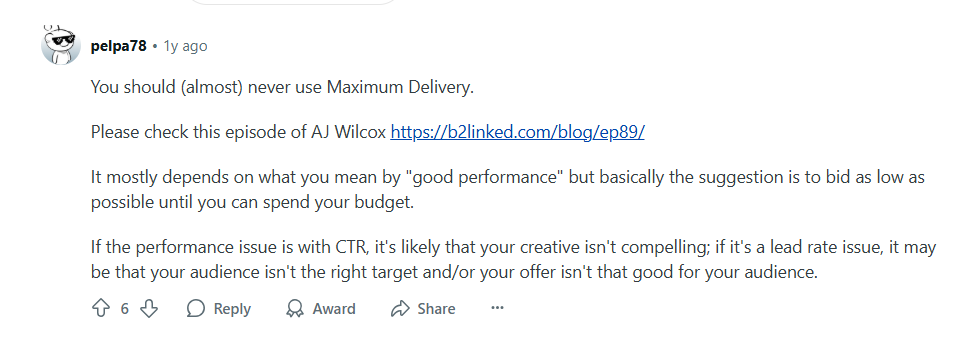
- Some experts also found that not only was manual bidding significantly better than smart/automated bidding, but it also didn’t alter the audience or intent, but rather brought cheaper traffic.
- The CEO of Getuplead B2B PPC Agency added a more nuanced opinion on the popular advice of ‘bid manual and bid low’. He said that manual bidding in the lower range can get the cheapest clicks, but you might end up targeting junior profiles that are not your ICP, reducing the number of quality leads. He added that one can try increasing the bid by 25 to 30% and see if that works any better (and he guesses that it would).
D. Don’t Forget Exclusions
Even if you upload the perfect target list for your lean ABM strategy, you’ll still need exclusions.
Like, cutting out current customers unless it’s an upsell or dropping job roles that don’t matter, like HR or Accounting.
Also, exclude job seekers, interns, or random industries that slip in. This saves spending and keeps ads only in front of real buyers.
Pro Tip: Block competitors so they don’t spy.
4. Aligning Ads with Sales Outreach (Turning Engagement into Pipeline)
Sales and marketing alignment is pretty fundamental to Lean ABM or ABM in general.
Achieve it this way:
- Remember that ads don’t close deals, sales does.
- Use ad engagement as sales triggers (5+ clicks, 50% video view, high impressions).
- Send weekly hot account reports to sales.
- Automate with tools (LinkedIn Company Engagement, ZenABM API, CRM workflows). For instance, you can pull LinkedIn ad engagement metrics from LinkedIn ads official API and automatically push them to your CRM as company properties using ZenABM:
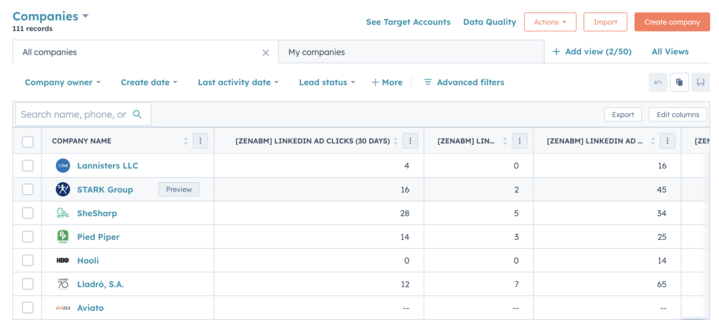
LinkedIn ad data pushed to company lists in the HubSpot CRM using ZenABM - Define MQA criteria (e.g., 5+ clicks = ready for sales), and once an account hits it, go for personalized BDR outreach.
- Personalize outreach using ad topics they clicked. You can see that in ZenABM, provided you tag each campaign with its intent:
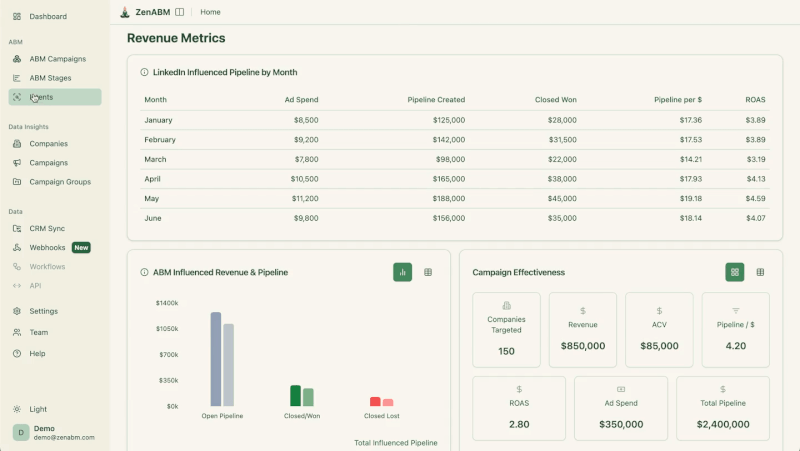
- Run multi-touch sequences (15+ touches, 3–4 weeks, across email, calls, LinkedIn, DM, ads).
- Act fast: follow up within 24–48 hours of strong signals.
- Align ads with timely outreach to turn clicks into pipeline.
5. Nurture and Retarget: Staying Top-of-Mind for Engaged Accounts
Getting a target account to click is just the start. Lean ABM makes that click count by retargeting only the right accounts.
- Build remarketing lists tied to your account list, not random audiences.
- Segment by actions like ad clicks, video views, or pricing page visits.
- Every impression should hit only ICP accounts, keeping spend tight and focused.
- Also, the retargeting content must be sharper than first-touch. Go for use case studies, testimonials, competitor comparisons, and strong CTAs like demos or ROI offers. Sequence it: awareness piece → case study → demo ad. Rotate 3–4 ads over a month to avoid fatigue.
- High-intent accounts might even warrant special offers or incentives.
- If one account clicks on everything, sales should double down fast.
- Expand beyond LinkedIn when possible. Use emails for nurturing or load them into cheaper platforms like Facebook, Google, or even Twitter custom audiences.
- Always measure LinkedIn ad engagement metrics at the account level using tools like ZenABM:
 Aggregate activity matters more than one lead.
Aggregate activity matters more than one lead. - If an account stays dead after a full cycle, cut it loose and replace it. A lean ABM strategy means keeping only accounts worth the chase.
6. Measure, Learn, and Optimize (Continuous Improvement)
In a lean ABM campaign, data is your best friend. You’ll want to rigorously track what’s happening at the account level and quickly iterate based on what the data tells you.
Because your scale is smaller, you can often spot patterns and adjust on the fly.
Here’s how to measure and optimize effectively:
Track Account Progression
In lean ABM, focus on account progression, not just ad clicks.
Define stages like Identified, Engaged, Interested, Opportunity, and Won.
You can use Kyle Poyar’s ABM stages framework for that:
Track how many accounts move between these stages weekly. If accounts stall, fix the bottleneck (content, targeting, or sales tactics). These conversion rates reveal what’s working and where to optimize.
Measure Pipeline and ROI
Pipeline and revenue are the real success metrics. Calculate pipeline per dollar spent, including ad, tool, and time costs. Compare outcomes against cold outbound or other channels to see where ABM delivers efficiency gains.
And if you don’t want to build such dashboards on your own, ZenABM provides plug-and-play, ad-influenced pipeline and revenue reporting dashboards:

Optimize Ads and Attribution
Look for clear ad winners by message, format, or offer, then double down.
Use ZenABM to see account-level engagement for each ad creative and the performance of each individual ad creative and campaign group:

Attribution is messy in ABM, so track results at the account level—clicks, views, and eventual deals. Even simple CRM cross-checks can reveal which accounts your ads influenced.
Iterate and Celebrate Wins
Lean ABM works best when you adapt quickly. Swap underperforming accounts, test new content, and fix weak landing pages. Document patterns you see in ICP behavior and refine each cycle.
Celebrate key account wins to keep momentum high: quality meetings and pipeline from target logos matter more than raw lead counts.
How ZenABM Can Support Your Lean ABM Strategy for LinkedIn Campaigns
If you are running Lean ABM on LinkedIn, do two things:
- Start with LinkedIn. It is the most B2B-ready platform for precise account targeting.
- Use ZenABM to operationalize your LinkedIn ABM and move fast.
Why ZenABM for Lean ABM on LinkedIn:
Company-level Engagement Tracking Per Campaign Using LinkedIn’s Official API
ZenABM pulls company level LinkedIn ad engagement data (impressions, clicks, and engagements) and ad spend for each LinkedIn ad campaign. You see which accounts are warming up by campaign and time window, without guessing.


Engagement-Based Lead Scoring and ABM Stage Tracking
Apart from showing raw engagement data per company, ZenABM sums historic and current activity into a company score that reflects awareness and intent. You get an at-a-glance signal to prioritize accounts. 
Based on engagement and your CRM data, ZenABM assigns an ABM stage to each account. The engagement thresholds for these stages are fully customizable.
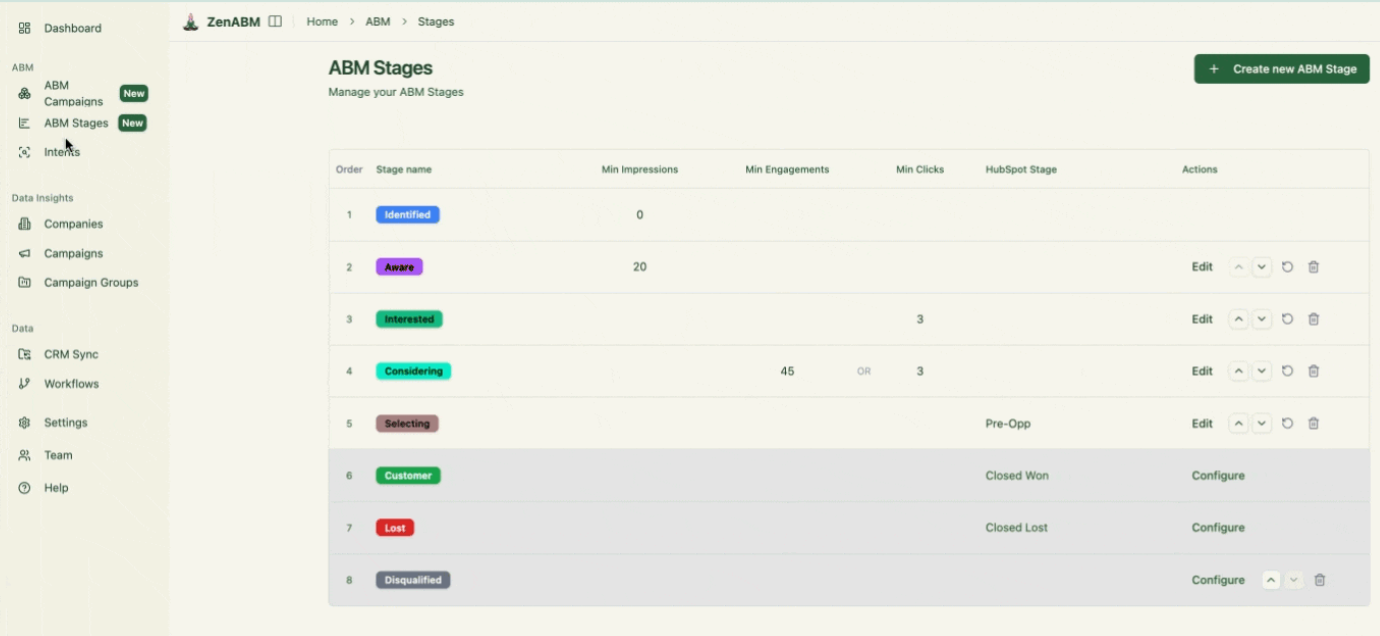
Automated BDR Assignment
We just saw that ZenABM tracks the ABM stage of each account based on engagement and CRM data.
To keep sales motion instant, ZenABM assigns hot accounts that hit your Interested threshold to BDRs in your CRM:

Your BDR outreach starts immediately without daily lookups or manual Slack alerts.
Two-Way CRM Integration
While you run ABM on LinkedIn, marketing can live in ZenABM and MAPs, and sales can stay in the CRM. ZenABM automatically pushes engagement as company properties to your CRM so reps see signals in their workflow.

For the other side of the sync, ZenABM matches engaged companies to deals in your CRM and pulls deal value for revenue context.
Plug-and-Play ABM Analytics and ROI Attribution Dashboards
ZenABM, powered by company matching and deal value, gives you ready-made ABM analytics and ROI dashboards.
- You can see ad performance at all levels, including ABM campaigns, LinkedIn campaign groups, and individual LinkedIn ad campaigns:
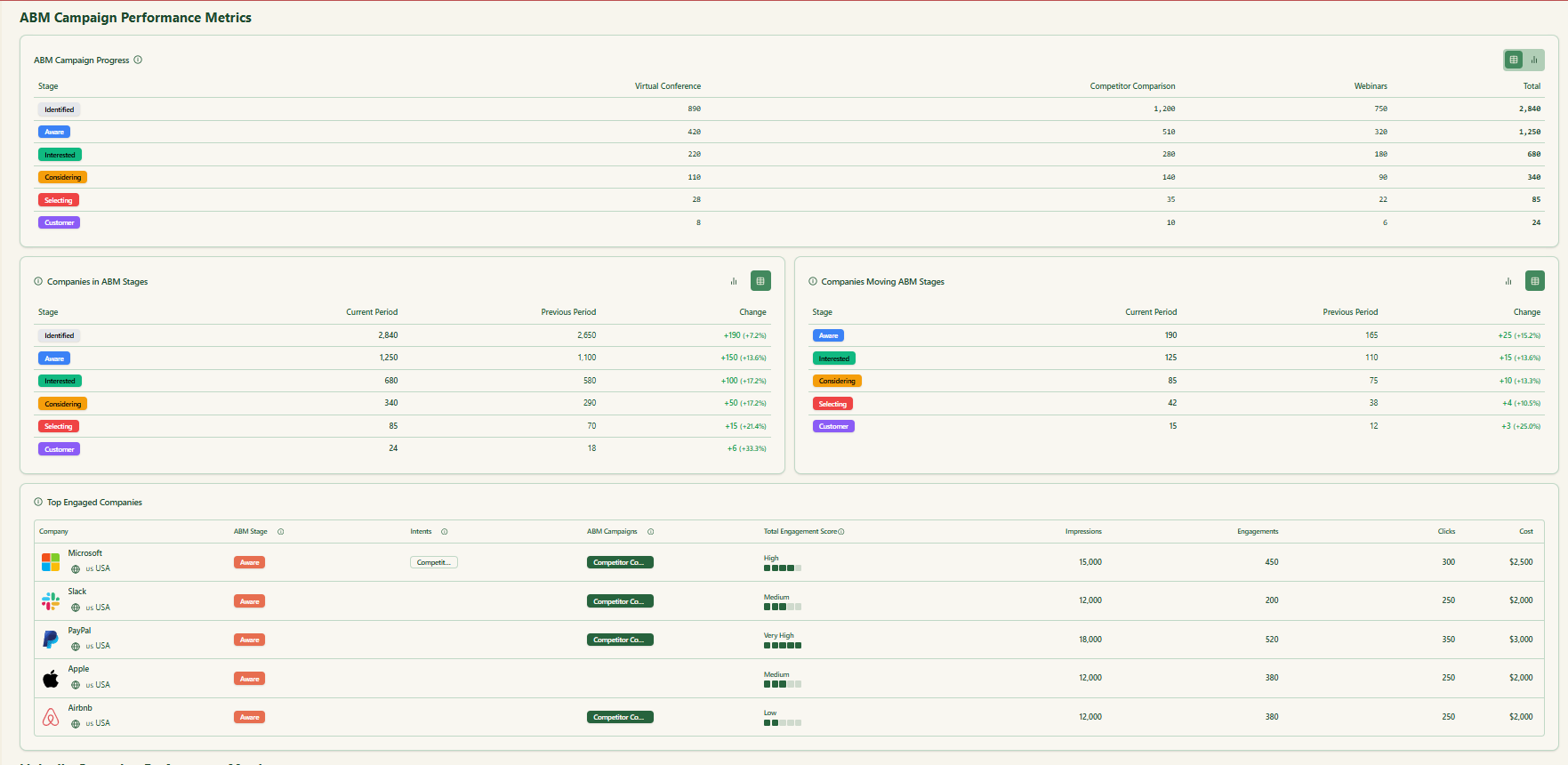

- With deal value and ad spend per company and campaign, ZenABM calculates ROAS and pipeline per dollar and plots pipeline visually:

Intent-Based ABM
Many ABM teams buy third-party intent like Bombora or use Demandbase or RollWorks to infer topics from keyword spikes. That adds cost and delay.
A leaner way is to encode qualitative intent in your ads themselves and tag campaigns by intent in ZenABM. For a product management SaaS, create campaigns for intents like product analytics, onboarding, session recording, or all-in-one.
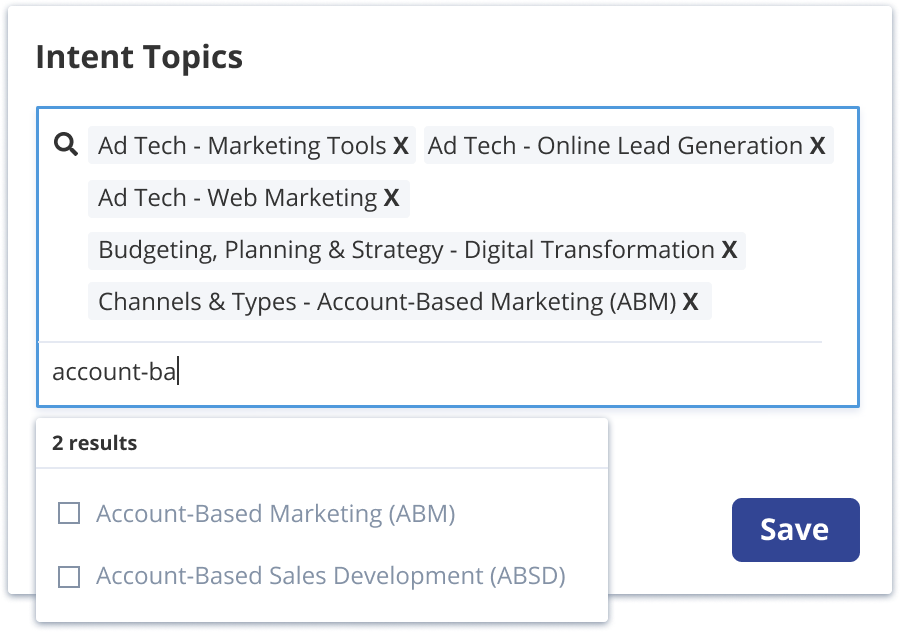
Something like this:
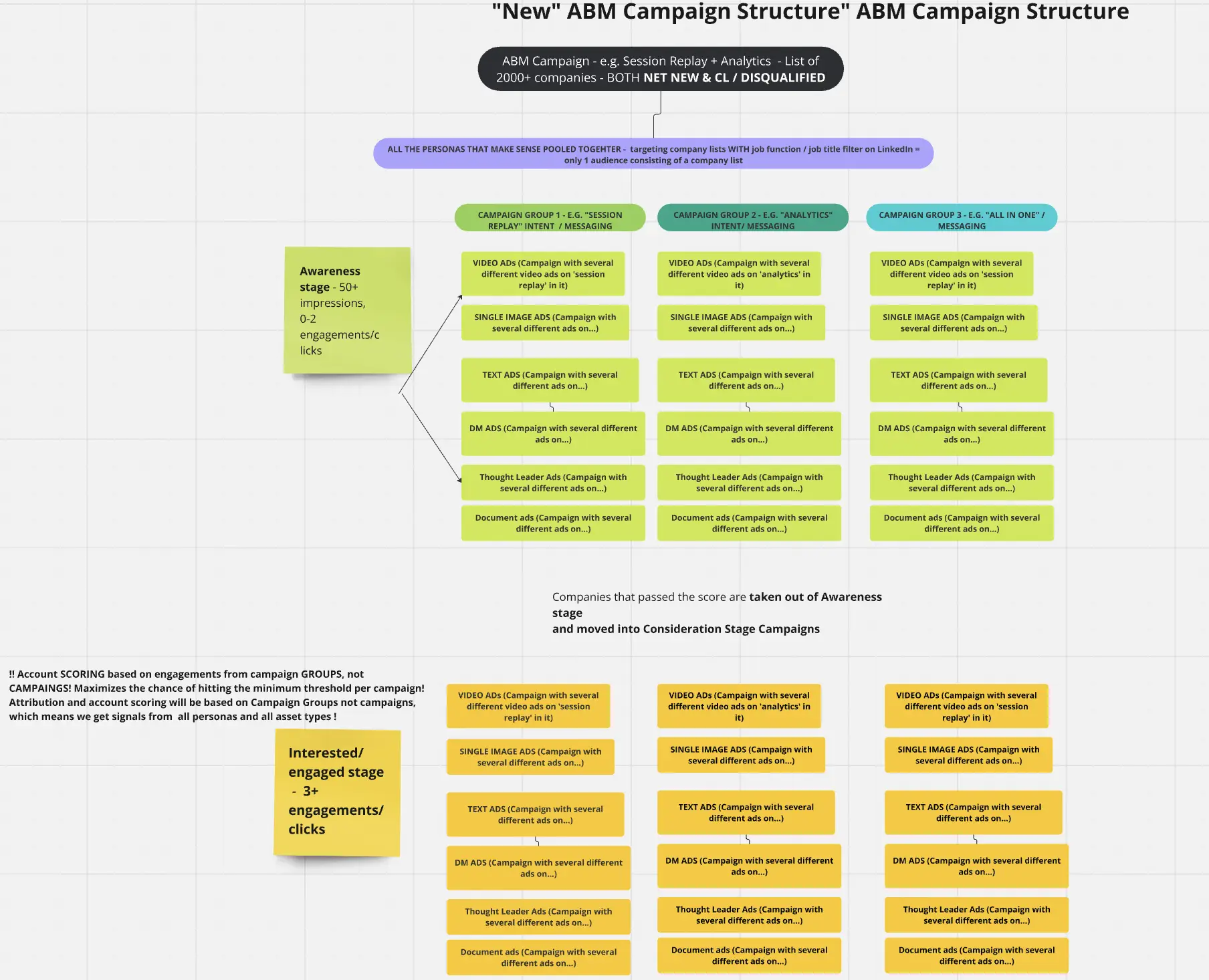
Then tag each campaign with intent in ZenABM so you see the qualitative intent per company:

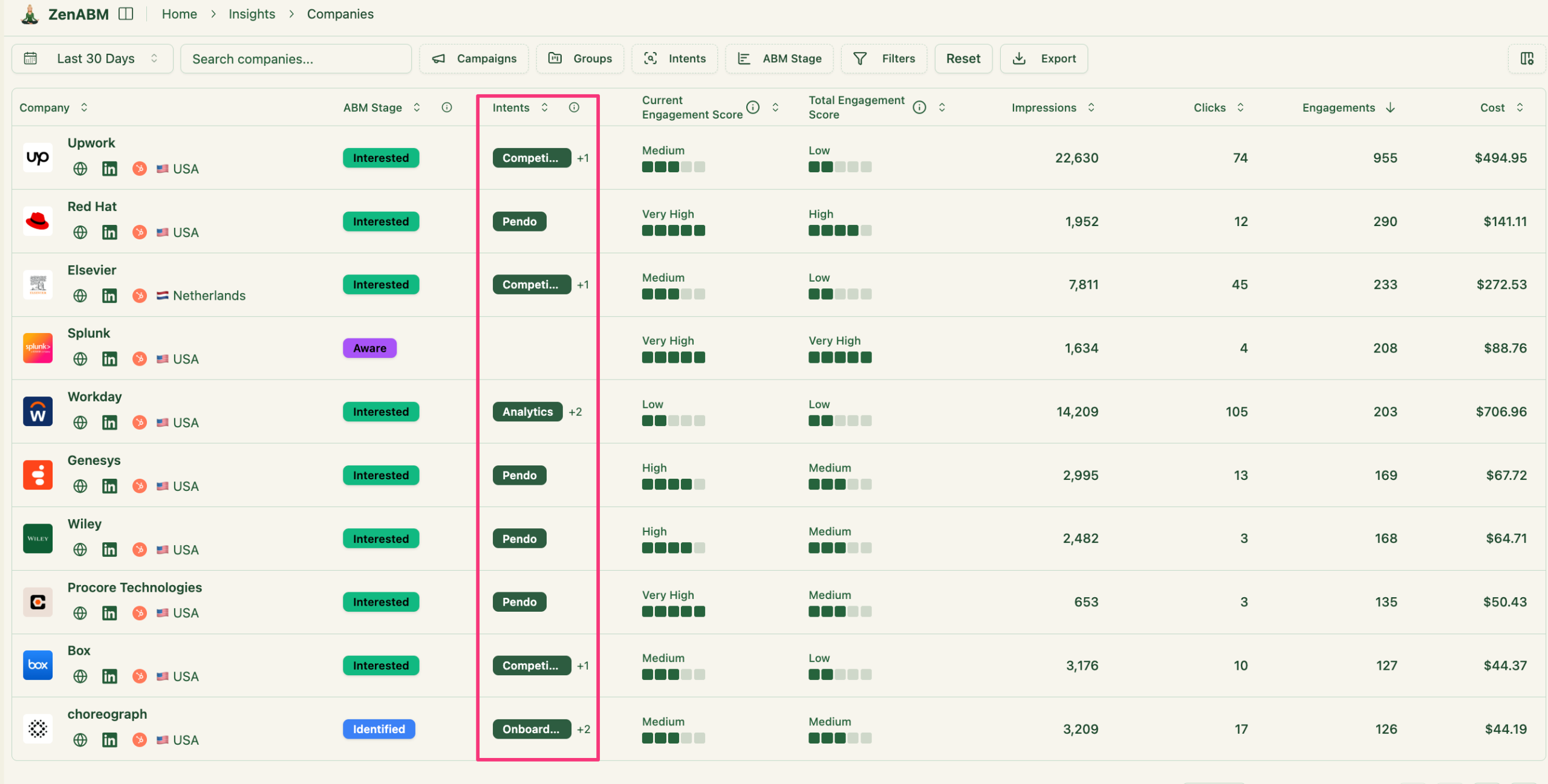
It will also group companies with similar intent for faster prioritization:
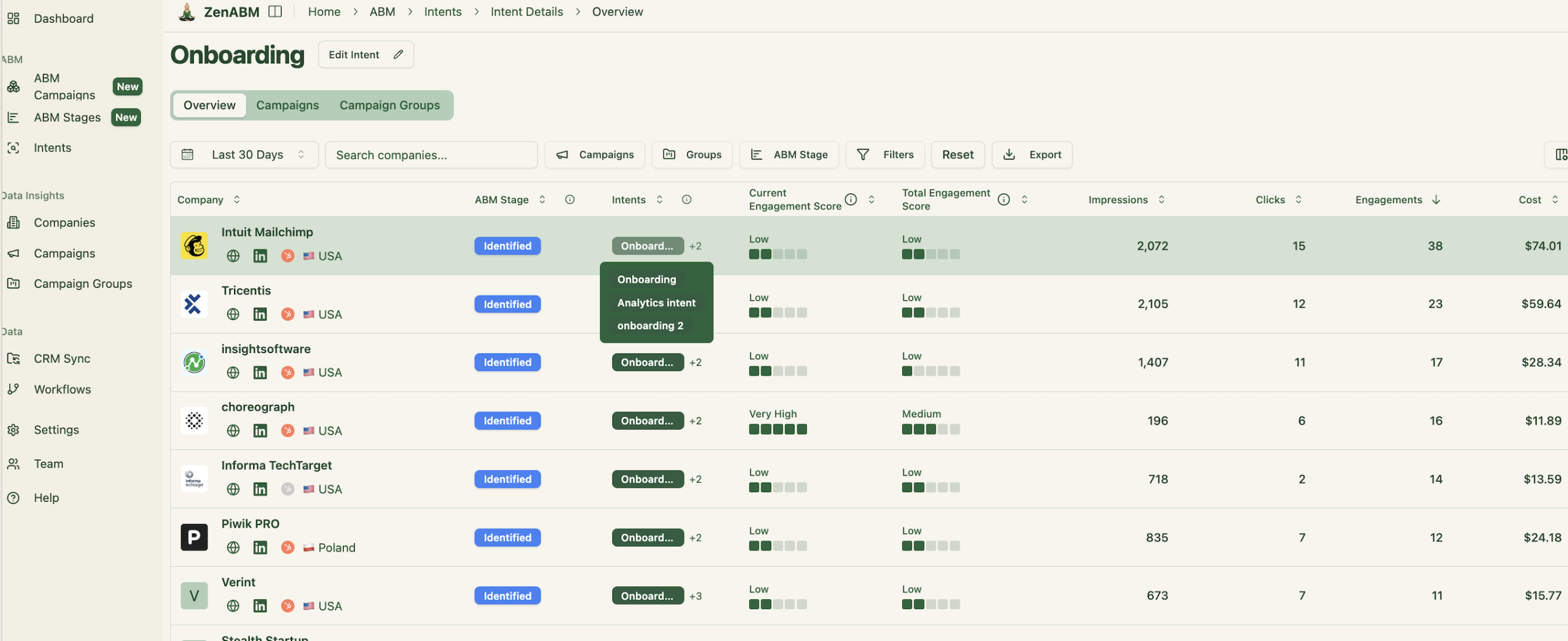
Plus, ZenABM will push intent as a company property to your CRM:
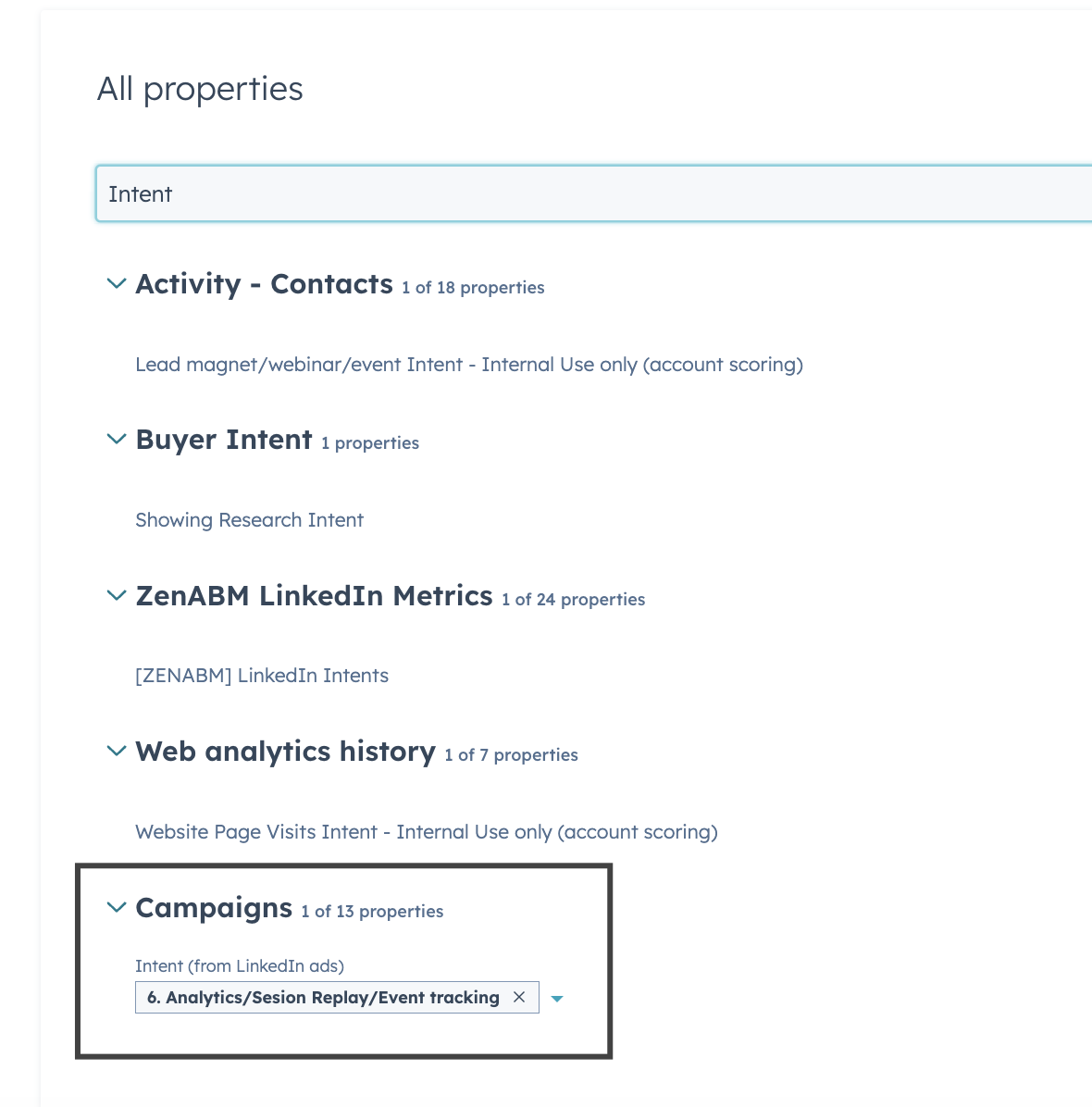
Your BDRs will know which accounts are hot and what to talk about on outreach.
Funnel-Leak Analysis
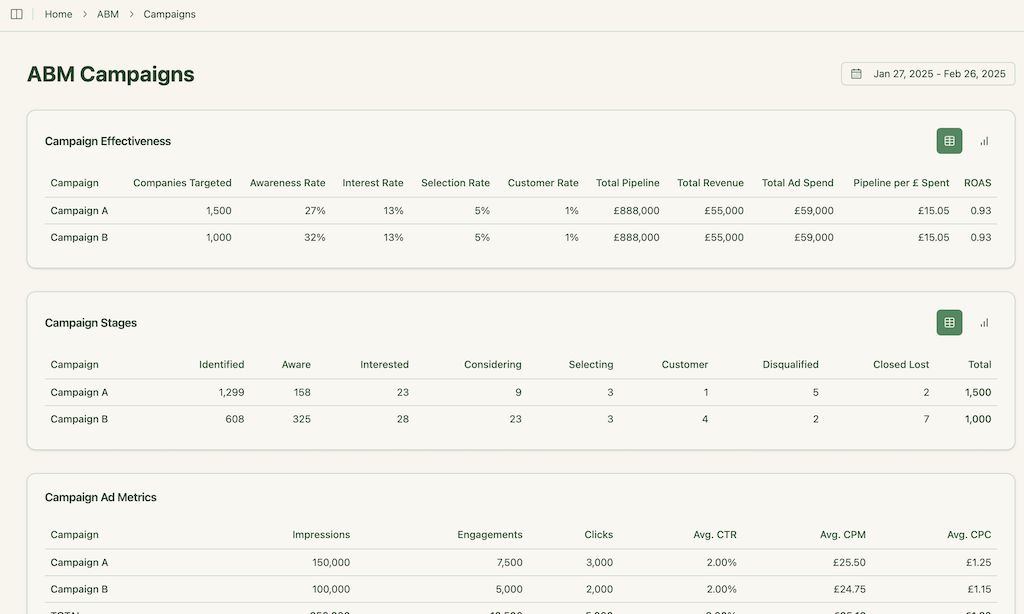
ZenABM maps how many companies sit in each stage and how they move. You spot friction fast and fix it.
For example, if many companies move from Aware to Interested but stall there, update your sales follow-up or retargeting offer to push them to Meeting.
Over to You
You do not need a six-figure stack to run ABM that works. You can go for a pretty lean ABM strategy (yes, even in this economy!).
Start with a tight TAL, show relevant messages to the right personas, and use engagement to time human outreach.
Keep frequency in check, exclude junk, and retarget only the accounts that lean in.
Measure progression from Identified to Won and report pipeline per dollar so leaders see impact fast.
When an account crosses your MQA line, act within 24 to 48 hours and reference the exact themes they engaged.
ZenABM makes this easier by surfacing company-level impressions, clicks, and intent inside your CRM and by triggering BDR handoffs and making revenue attribution dashboards automatically.

